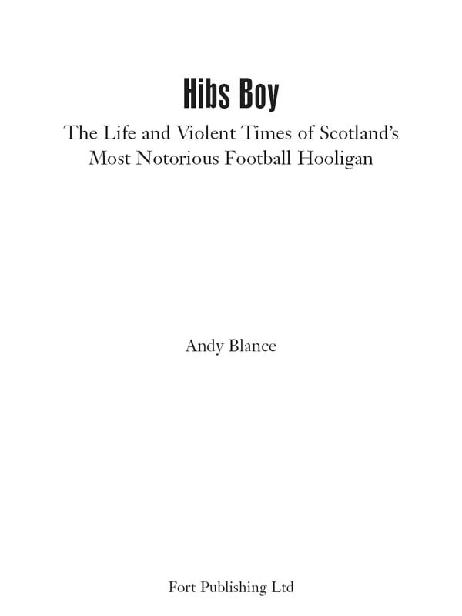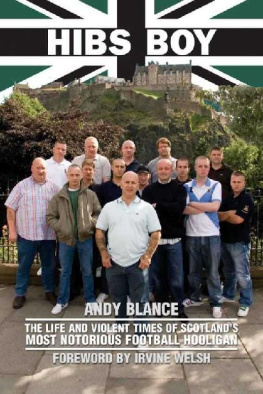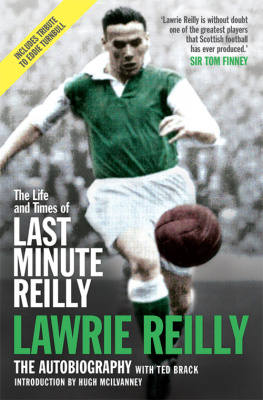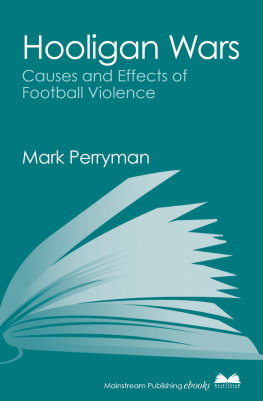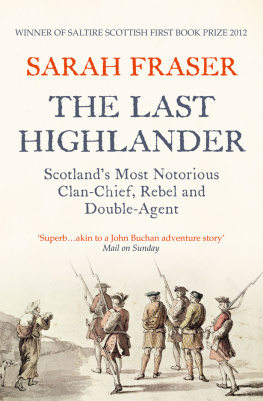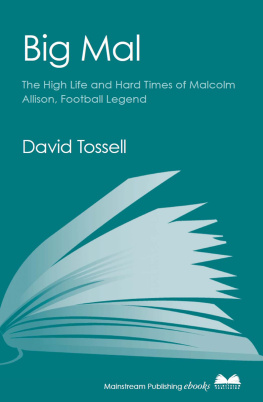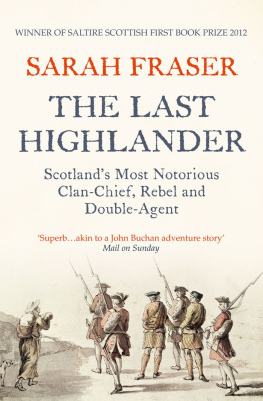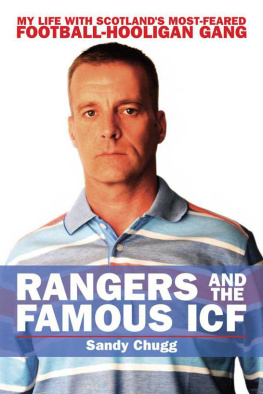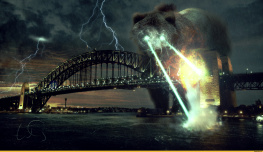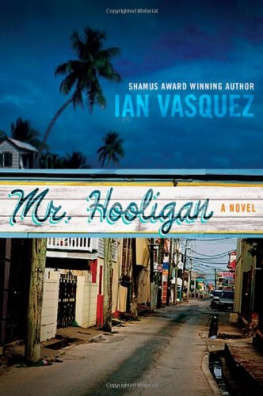Hibs Boy
The Life and Violent Times of Scotlands
Most Notorious Football Hooligan
First published in 2009 by Fort Publishing Ltd, Old Belmont House,
12 Robsland Avenue, Ayr, KA7 2RW
This edition first published in 2010
Andy Blance, 2010
All rights reserved. No part of this publication may be reproduced, stored in a retrieval system, or transmitted, in any form or by any means, electronic, mechanical, photocopying, recording or otherwise, without the prior permission of the publishers and copyright holders.
Andy Blance has asserted his rights under the Copyright, Designs and Patents Act, 1988 to be recognised as the author of this work.
Printed by Bell & Bain Ltd., Glasgow
Cover photograph by Dougie Thomson: www.dougiethomson.com
Typeset by 3btype.com
Graphic design by Mark Blackadder
ISBN: 978-1-905769-19-3
eISBN: 978-1-905769-35-3
CONTENTS
FOREWORD
Irvine Welsh
It was around 1984 when I first became aware of the growth of the casual movement in Edinburgh. Id been living mostly in London since 1978, but still came up to my home town on a regular basis for Hibs games. The Whelahan bus, run by my friend, Scott Bootland, contained a motley crew of 1970s Hibs hooligans, northern soul freaks, punks, mods, piss-heads, drug-fiends and other misfits. We werent affilated to the official supporters associations, thus the Whelahan was one of the few buses that let on so-called casuals; boys around 1417 years of age, many of whom were younger relatives and friends of the Whelahan regulars. (Another bus with an open-door policy towards the emerging teenage mob was the Liberton branch, which Andy Blance and his mates regularly travelled on.)
A lot of the older lads in their twenties and thirties disdained these teenagers, with their strange clothes, lack of scarfs etc, but although I was ten years too old and way too badly dressed to be a casual, I recall being quite impressed at the time. I thought they had a bit of sartorial style (when I thought about Mickey McMillans green site helmet and gold Doc Martens in the early seventies) and that they all seemed pretty tight with each other.
It was easy to understand the reticence of the old guard. Hooliganism in the seventies was a very different phenomenon to its 1980s incarnation. It was possible back then to indulge in aggressive activity at football, without necessarily being labelled a hooligan. Football terraces back then were noisy, colourful theatres, and you could choose to be centre stage or elect to wait in the wings. In other words, it was a type of behaviour that one could flit in and out of, rather than the determined lifestyle it would later become.
Also, in the seventies, the street-gang culture was the dominant force in Edinburgh. You had the Leith Team, Niddrie Terror, Mental Drylaw, Lochend Shamrock, Pilton Derry, Inch Cumbie etc etc, all prefixed with a youthful Y. (My personal favourite moniker of the time was Y-MASS the Young Mental Amsterdam Shotgun Squad.) This meant that apart from the Edinburgh derby against Hearts, and the visit of the Glasgow clubs, aggro at Easter Road was quite often between Hibs boys from different parts of the city.
The away games tended to promote more solidarity, and this was how many people got involved in hooliganism in the seventies, simply through being a travelling fan. For me it was as mundane as having a preference for the train as I got car and bus sick as a kid. But this mode of travel meant having to navigate the inevitable reception committees of would-be ambushers on the walk from the station to the ground. So it made sense to stick together, with other young Hibs fans. You initially attended these fixtures with friends from your own area or your local school, but soon made pals from other parts of the town; in my case, Mickey and Kenny McMillan and Bob Carlin from Niddrie, John Boyle, Jimmy Lugton, Jimmy Crawford and Deano Rafferty from the South Side, George Shipton and James Scrap Ferguson from Tollcross.
In the seventies, the media hadnt got a proper handle on hooliganism to any great extent. As it changed and developed, it took them a very, very long time to come anywhere near understanding the phenomenon. The first chant I heard referencing it at Easter Road was hooly-hooly-hooly-gans; a largely disapproving cry, almost pointing out troublemakers, and even when this morphed into a prouder statement with songs like Eddie Turnbulls Soccer Hooligans there was still an ironic, tongue-in-cheek aspect to it all.
Throughout the seventies at Easter Road, despite the odd notable battles on the way to the ground, the hooligan scene inside the stadium exponentially declined. This was mainly to do with putting seats in the Cave or Cowshed (the covered terracing where the Famous Five now stands), killing much of the atmosphere at the ground. The more vocal Hibs fans used to congregate here in the sixties, but it became the centre of trouble with missiles coming onto the pitch from this tightly packed area, and clubs who brought a big travelling support (Hearts, Rangers, Celtic) would try and take this end. Back then, there was a drive to shut down or nullify problem areas of terracing. Brian Clough once famously threatened to shut the Trent End at Nottingham Forest.
Emasculating the Cave by transforming it into what was the dreariest seating area in the history of the game was a big blow, as it dispersed the home singing support (and hoolie element within it) onto the inhospitable slopes of Shaw Heights, the huge, open main terracing. Though some of the more raucous elements decanted to the North Enclosure, the atmosphere didnt pick up inside the stadium till Shaw Heights was levelled and covered, forming the East Terracing which still exists today, augmented with bucket seats.
This lack of atmosphere was compounded by the railed sectioning of the ground, which meant rival supporters could no longer change ends at half-time. Then, following Hillsbourgh in 1997 and the Taylor report, and the riot at the 1980 Scottish Cup final, the immediate segregation of rival supporters was enforced and a timetable for all-seater stadiums was established. This had the effect of changing the nature of hooliganism; the big rows now happened almost exclusively outside the stadiums.
It changed the hooligan too. There was always a largely performative element to seventies thuggery, with its taunting and occasionally charging across the no mans land between rival fans and spilling onto the pitch. However, with the numbers involved (due to the mixing of drunks, singers, kids looking for excitement with genuine hoolies) it could be a lot more dangerous for bystanders. But the changes in fan organisation, policing and stadia meant that hooliganism became a more serious activity for the participants. Some thought had to go into the row; you couldnt simply just show up at the ground and expect it to go off. While these developments made life safer for the so-called average fan, it became increasingly more dangerous for the hooligan, who now had to be a serious street-savvy player, rather than a dilettante just coming along for the laugh.
One thing that struck me as being different at the games I attended in London was that generational gap in hooliganism at Hibs. Down there, the old school thugs tended to stick with it, while the 70s hooligans at Easter Road saw it being a largely teenage thing, and tended to disdain it as they moved into their mid-twenties. A lot of this was undoubtedly to do with the impact of the street gangs as the main focus of thug loyalty; fighting on a Friday night with your mates in Rose Street against boys from another scheme was more acceptable than fighting on a Saturday afternoon against boys from another city. This changed with the new breed of Hibs hoolie (as they were back then in the mid-eighties), who were a tight, well-togged mob, drawing boys from all over the city and beyond. For the first time ever, Edinburgh had one, big, united firm. This basically is where Andy Blance and the CCS come in.
